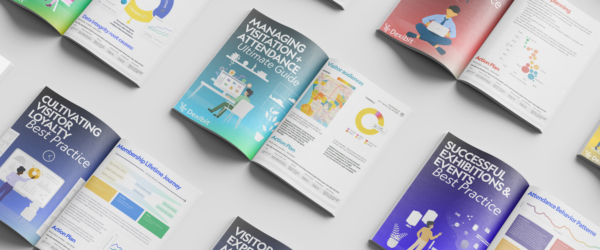Configuring your ticketing systems for visitor insights
- In Visitation, Visitation Data, Visualisations
- Articles
- 5 min read
Ticketing systems have been a savior for many visitor attractions managing new or tighter capacity constraints in the age of COVID-19, with the added benefit of aiding contact tracing too. Those rolling out new ticketing systems, introducing online bookings or managing for capacity for the first time, there is a lot of insight to be gained from ticketing data.
Configuring your new ticketing system with insights in mind can uncover much more about your visitors than obvious at first glance – providing a unique look into target markets, visitor activities, booking behavior and more. To get the most of your data, it pays to have a system of intelligence for forecasts, insights, dashboards and reports – alongside your system of record managing your tickets – with the added benefits of democratizing access across the wider team and pulling together all your various data sources, including ticketing, under one roof.
In configuring your ticketing system, here are five foundations to manage for:
Sold, scheduled, redeemed or scanned?
Tickets have their own journey – from the date and time they’re sold or booked, the date and time they’re booked or scheduled for (if specified), and when they get redeemed or scanned (which sometimes occurs multiple times, if they are a multiple use pass, or a pass that will be used at multiple checkpoints onsite). To support capacity management and booking curve analysis, you’ll need to be able to capture date and time stamps from each of these status fields. In addition to operationally planning for how many visitors are booked to come on a certain day and peak periods of attendance, this can also lend insight into visitor behaviors such as booking windows (how far in advance your visitors plan their visit) and attrition rates (when visitors book a ticket and don’t show up), or correlated with context such as advertising campaigns or ticket release rules, to optimize demand versus capacity.

Attrition versus redemption rates for admission performance
What they do and who they are: ticket products and types
Tickets have a number of tiers or hierarchies which can be used to better understand what your visitors are doing and who your audience is. Ticket products usually refer to what the visitor is doing in your venue, whether that’s general admission or an activity such as an event, experience or exhibition. If you’re able to capture tickets for specific activities in your venue, you can then measure against overall attendance to understand visitor conversion rates, comparative trends and changes over time – such as how a special exhibition is performing.

Experience conversion plotting visitation conversion to a ticketed exhibition
Ticket types usually refer to who your visitor is – such as differentiating between adults, seniors, different grades of students, military or members. Even if your tickets are free or your pricing structure doesn’t differentiate between these, by configuring to capture this, you can learn a lot about who your target audience is and how to better cater to their interests.
Origin, country, and zip codes
Knowing where your audience is based is crucial to both understanding target audiences and planning location based advertising – plus in the age of COVID-19, monitoring the impact of travel restrictions and tourism decline. Taking zip or postal code from tickets provides a means to plot where visitors come from and get an idea of popular target markets, untapped regions and even as a measure of diversity. For an in depth picture, try use household census data to extrapolate other demographics from this data.

A choropleth heatmap of visitor origin by zip code at a neighborhood level.
Path to purchase
Information on visitor channels provide important insight into how your visitors discover and plan their visit to your venue and how various go to market approaches are performing, such as Online Travel Agencies (OTA) or local tourism partnerships such as city pass schemes. Configure ticketing data to differentiate between walk up versus advance bookings, online versus phone or box office and third party sales. For partnerships, this data is also incredibly important for channel partner settlement too – to either collect revenue from a third party booking or to payout commission to an agent. Online, separate landing pages for various referrers which pass a channel code into the ticket booking well help delineate between various organic and paid channels.
Ticket price
In addition to recognizing and reconciling revenue, insights on pricing are particularly useful if you’re running variable or dynamic pricing structures, or to keep an eye on discounting and free admission including member or season pass visits (especially for at capacity venues, where these tickets also bear an opportunity cost of a lost paying visitor). Offering a range of pricing for admission or activities provides an opportunity to analyze price effect (such as whether ticket price and onsite spend correlate) and price elasticity or sensitivity (though less so for variable pricing structures that are fixed to time based trends such as seasons or days of the week). Alongside price itself, discount or offer codes provide a way to track promotions and campaign success – a tactic also useful at point of sale for other lines of business outside ticketing.
If you’re implementing a new ticketing system, in addition to working through the data you need for the insights you’re after, make sure your ticketing system is preferably a modern, cloud based software with a stable Application Programming Interface (API) with strong endpoint coverage of the above data points, used to integrate ticketing and analytics system to extract data. It’s also important to make sure that front of house visitor services teams who are issuing or scanning tickets understand what data is used for and why data quality is important – for example, to avoid common issues such as staff entering the venue’s local zip code on a booking they’re processing or skipping scanning tickets at entry.
Key to it all is a team with strong data governance, especially provenance – knowing where data comes from, what happens to it along the way and who has access to it. To achieve trust through transparency and control in data, you’ll need purposeful, documented and commonly understood business rules (including naming conventions) that are integrity inspected.
Lastly, don’t waste the opportunity of collecting a visitor’s email address, either for advance bookings online or even for box office onsite. With the right transparency and permissions around privacy, these email addresses can be used to send a reminder in advance of the visit with helpful information about visiting, plus a thank you email following the visit together with a Net Promoter Score (NPS) survey, member offer and email subscription option.
Want to learn more about Dexibit?
Talk to one of our expert team about your vision to discover your data strategy and see Dexibit in action.





